by Les Harrison | Dec 2, 2013
Tarzan used them as a superhighway through the trees in every adventure created by Edgar Rice Burroughs. Villains and scoundrels alike fell prey to the ape-man and his horde of avenging simians descending on vines from the trees.
Great fiction, but removed from the reality of present day panhandle Florida. This is especially true about the vines which are impossible to use as a propulsion system and in many cases are exotic invaders.

Kudzu Vines Covering native vegetation – Image Credit Les Harrison UF IFAS
The most infamous is Kudzu (Pueraria montana), sometimes known as the weed that ate the south. It was introduced into the United States at the Philadelphia Centennial Exposition in 1876.
By 1900 kudzu was available by mail order as inexpensive livestock forage, and later sold by the USDA as an erosion control. The vigorous nature of the plant allowed it easily to escape into the wild.
It now exists in impenetrable tangles as large as 100 acres killing trees, covering structures, and smothering native plants. Kudzu is an aggressive leguminous vine capable of growing one foot per day. It can easily grow 60 feet in a single growing season.
It establishes roots sporadically as it covers an area, layering vines and foliage on top of each other. One key to this plant’s efficiency is its ability to orient each leaf so that the maximum amount of sunlight possible is absorbed. This multi-directional orientation of leaves also poses special problems with sufficiently wetting the top sides of foliage with herbicide.
Special effort is necessary to control kudzu. Older, well established plants are harder to control and completely eradicate. Follow-up spot treatments can require five to ten years in extreme cases. For easiest access, it is best to evaluate kudzu problems in winter when vines and foliage are withered.

Japanese Climbing Fern – Image Credit Les Harrison UF IFAS
Japanese Climbing Fern (Lygodium japonicum) is another aggressive exotic invasive, but not as commonly recognized as Kudzu. It is presently the only non-native invasive fern in the Florida.
Japanese climbing fern is a delicate looking perennial climbing vine. It is capable of forming a dense mat-like thatch capable of covering trees and shrubs. Initially, it was introduced from Japan as an ornamental.
This fern reproduces and spreads readily by wind-blown spores. Animals, equipment, and even people who move through an area with climbing ferns are very likely to pick up spores and move them to other locations.
It is scattered throughout the lower portions of Alabama, Georgia, Louisiana, South Carolina, and much of Florida, including panhandle. Planting or cultivation of this vine for ornamental purposes is prohibited by statute.
Both vines have many negative attributes. Among these are crowding out native vegetation, harboring destructive insects and diseases, and providing a fire bridge to the crown of unlucky trees.
Adequate control of both exotic vines has been achieved with multiple applications of herbicides. As with most invasive plants, repeated and correctly timed treatments are likely to be necessary.
Contact your local UF IFAS Extension office for more information

by Gary Knox | Dec 2, 2013
Acer fabri (Faber’s Maple) is unlike maples familiar to most people as it does not have the typical three or five-lobed leaves. Instead, leaves of Faber’s maple are un-lobed, slender and very glossy. In addition, most people know maple as a deciduous tree, dropping its leaves in fall, whereas Faber’s maple is evergreen.
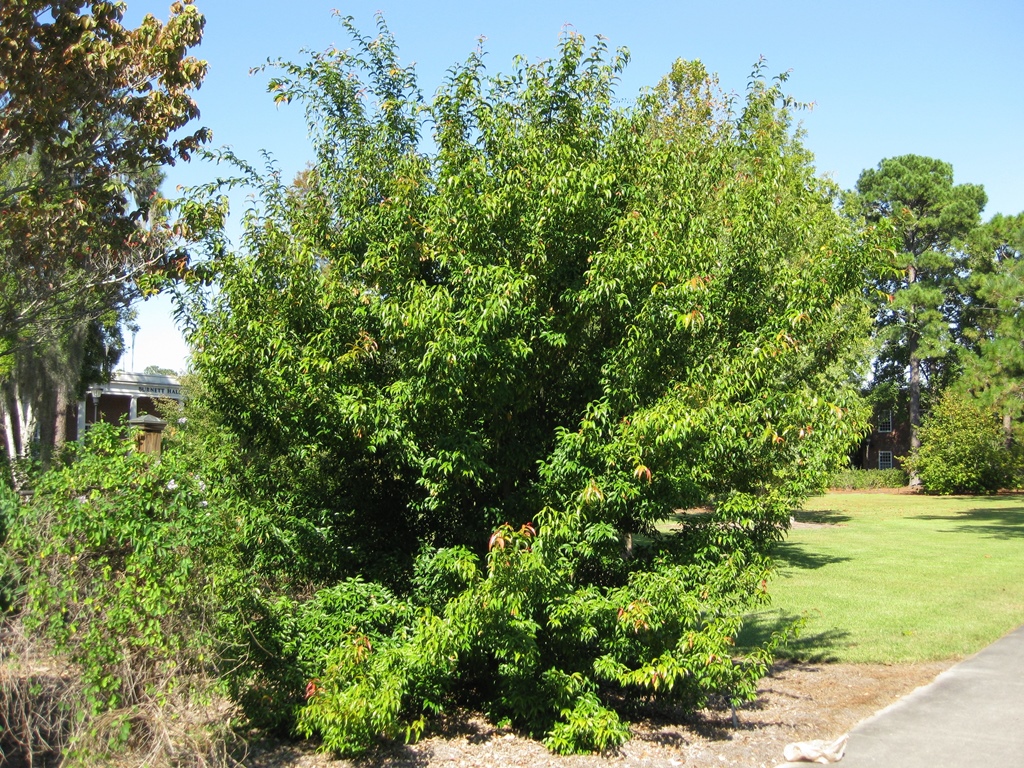
Figure 1. Acer fabri, Faber’s maple. (Photo by Gary Knox)
Faber’s maple grows as a small, broad tree up to a height of about 30 feet. Leaves on new growth are tinted red, and the familiar samaras (“helicopter” fruits), appearing in September, are also red. New growth on some trees has more red coloration than on others, suggesting the possibility of selecting forms with more red coloration. Hardiness is not confirmed but it is believed to be adapted to USDA Cold Hardiness Zones 7b-9. Leaves reportedly senesce and fall when winter temperatures drop to the low 20s or high teens (°F). Accordingly, Faber’s maple is likely to be evergreen in most of Florida and semi-evergreen after cold winters or when grown in the cooler areas of its hardiness range.
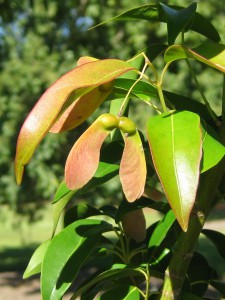
Figure 2. Closeup of the red tinted leaves and fruits of Faber’s maple. (Photo by Gary Knox)
Faber’s maple is native to mixed forests of Vietnam and central and southern China, where it is known as “luo fu feng”. This slow-growing tree fares best in partial sun and well-drained soil. No serious pests are known at this time.
The reddish new growth, glossy green leaves, red fruits and growth as a small evergreen tree collectively make this a very ornamental tree. Rare in cultivation, Faber’s maple deserves to be planted and evaluated more widely. Propagation is by seed and reportedly summer cuttings.
Acer fabri (Faber’s maple) has not yet been evaluated using the IFAS Assessment of Non-Native Plants in Florida’s Natural Areas web assessment tool. Without this assessment, the temporary conclusion is that A. fabri is not a problem species at this time and may be recommended.
by Les Harrison | Dec 2, 2013
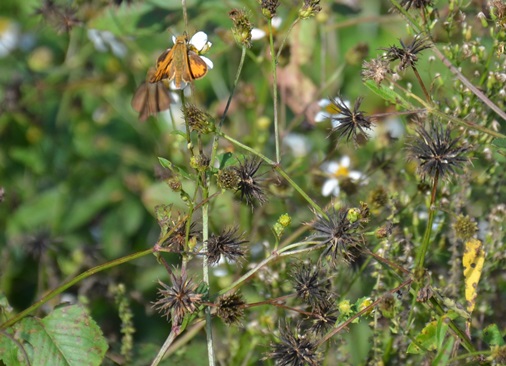
Bidens alba is locally know as Spanish Needles because of its stiff prickly structure. It will hitchhike to a new location on anything it contacts.
Hitchhiking was once a common means of low cost transportation. A person would walk to the nearest road and hold out their left fist with the thumb pointed up while attempting to make eye contact with drivers.
In a simpler time hitchhikers were commonly provided a ride to a predetermined spot on the map. In exchange they provided companionship and conversation to the driver.
Change in travel preferences notwithstanding, north Florida still has plenty of active hitchhikers which are seeking a cheap means of travel. The autumn environment stimulates plants with hitchhiking seeds to relocate to new territory open for colonization.
One of the most common hitchhiking seeds locally is Bidens alba. It is known by an assortment of common names including Spanish needles, Beggar’s-tick and Hairy Beggar’s-tick and is a member of the daisy family.
The genus name Bidens means two-toothed and refers to the two projections found at the top of the seed. The species name alba means white which refers to the flowers with white pedals and a yellow center.
This Florida native annual uses the two hooked prongs at the end of the seed to attach itself to anything coming into contact. Each plant produces an average of 1,205 seeds which germinate in the spring.
This weed is common in disturbed areas such as roadside ditches and fence rows with full sun exposure. It is capable of growing to six feet in height, but will take mowing and continue blooming.
The relatively recent interest in wildflowers has encouraged the propagation of this plant for landscaping purposes. Additionally, it is a popular late-season source of pollen for honeybees and other pollinators.
Hackelia virginiana is another hitchhiker currently active in the panhandle. Common names for this weed include Beggar’s Lice, Sticktight and Stickseed and mothers countywide have removed these from their children’s clothing.
The seed pods are approximately 1/8 inch long and are covered with stiff bristly hairs protruding in every direction. Like Spanish needles, anything which brushes against these seeds will carry at least a few to new locations.
The seed pods are green, but will dry to a dark brown. When the outer husk is peeled away, the seed appears as a tiny tan to white bean.
The plant is an erect and has a single stalk about three feet in height. This shallow-rooted plant produces a bloom in mid-to-late summer and seeds in October.
This biennial plant has yet to gain the appreciation of wildflower lovers. It is still considered a weed pest and treated as such.
One byproduct of hitchhiking weeds has been the invention of Velcro. One half of this product resembles coarse fabric and the other side mimics the texture of a cocklebur, a hitchhiking agronomic weed pest.
To learn more about the hitchhiking seeds, visit your local Extension office in person or on the web.

by Blake Thaxton | Nov 25, 2013
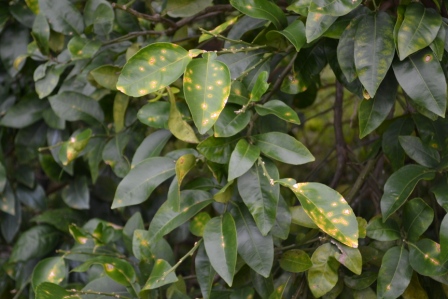
Citrus Canker lesions on leaves. Photo Credit: Beth Bolles, UF IFAS Extension – Escambia County
Authors: Blake Thaxton & Mary Derrick, UF/IFAS Extension – Santa Rosa Co. Mikaela Anderson, FDACS Division of Plant Inspection
Citrus canker is a serious disease of citrus trees that was recently confirmed for the first time in southern Santa Rosa County. Canker is caused by the bacterial pathogen Xanthomonas citri subsp. citri. Citrus canker has been a major pest of citrus in south and central Florida. It is economically damaging to the commercial industry and is also problematic to homeowners because it causes premature fruit drop, discolored fruit, and eventually causes the tree to become unproductive.
Canker was first introduced in 1912 into Florida and was declared eradicated in 1933. The disease was found again in the Tampa area on citrus in 1986. It was declared eradicated in 1994, but once again was found in 1995 in Miami. This time, the disease was not successfully eradicated in part because hurricanes made the disease too widespread to control. Despite its prevalence in south and central Florida, this disease has not been known in the Panhandle. The University of Florida and the Florida Department of Agriculture and Consumer Services’ Division of Plant Industry will be assessing the extent of the disease in Santa Rosa County in the coming months.

Lesions growing through the channels formed by the Citrus Leafminer insect. Photo Credit: Beth Bolles, UF IFAS Extension – Escambia County
How might you know if your citrus is infected by canker? One of the best indicators of canker is the presence of lesions, diseased spots, on the upper and lower surfaces of the leaves. The lesions will be raised and have a rough surface and will be surrounded by yellow halos. Similar lesions may be present on the fruit and stems as well.
[important]If you suspect that your citrus trees may have citrus canker please contact the Division of Plant Industry’s Helpline Center at 1-888-397-1517 before taking any action to reduce accidental spread of this disease. [/important]
before taking any action to reduce accidental spread of this disease. [/important]
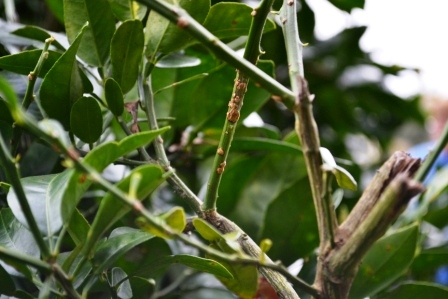
Lesions formed on the stems. Photo Credit: Beth Bolles, UF IFAS Escambia County Extension
The disease is highly contagious to citrus only and spreads rapidly through wind, rain and via people on their hands, clothes, and tools. Do not transport any plant material that shows symptoms of canker. Decontamination practices should be used when going from one citrus tree to the next. Hand washing with soap and water for 20 seconds or more to eliminate bacterium on the skin should be practiced as well as using alcohol-based hand sanitizer. Pruning tools or other tools that come into contact with citrus should be disinfected by a fresh solution of 1 ounce of household bleach to 1 gallon of water. An old or dirty bleach solution is not able to disinfect because the chemical is no longer active.
[warning]Do Not Move a Plant Infected with Citrus Canker. Please Call your local Extension Office for further instructions[/warning]
For more information on citrus canker:
(The University of Florida IFAS Citrus Canker website provides a photo gallery of disease symptoms & information about the disease)
by Mary Salinas | Nov 25, 2013
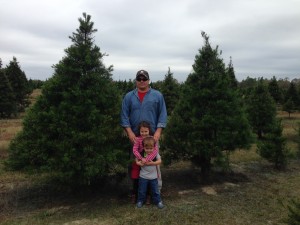
Whispering Pines Farm in Milton with proprietor Mike Kelly and children. Photo by Mary Derrick, UF IFAS.
One of the joys of this season is to bring home a fresh Christmas tree and enjoy the fragrance and natural freshness of a live tree inside your own home. Imagine how much fresher the tree would be if you harvested it!
The good news is there are Christmas tree farms in Northwest Florida where customers can choose and harvest their own Christmas tree! Visit the Florida Christmas Tree Association online to find the closest local Christmas tree farm. The website also offers information on tree varieties and how to care for harvested trees.
[notice] Here is a way to support your local farmer![/notice]
The varieties of trees grown in the panhandle are different from the northern trees brought south for the season. Christmas tree farms in the panhandle offer varieties such as Virginia pine, Leyland cypress, red cedar, Arizona cypress, Carolina sapphire, and Thuja “Green Giant’. Since these varieties do not grow naturally into the conical shape like northern-grown Christmas trees, the farmers take great care to train their trees into the traditional Christmas tree shape. Pruning and shaping the trees begins when they are about 2 years old and continues twice a year for as long as they are growing. The result is a tree that looks naturally shaped and ready for the tree stand.
Real Christmas trees are environmentally friendly as they are a renewable resource. Once trees are cut down, new ones are planted in their place. The trees are also reusable as mulch when chipped on-site or through county yard waste disposal services.
For additional information please see:
Christmas Trees and Their Care
Florida Christmas Tree Association











